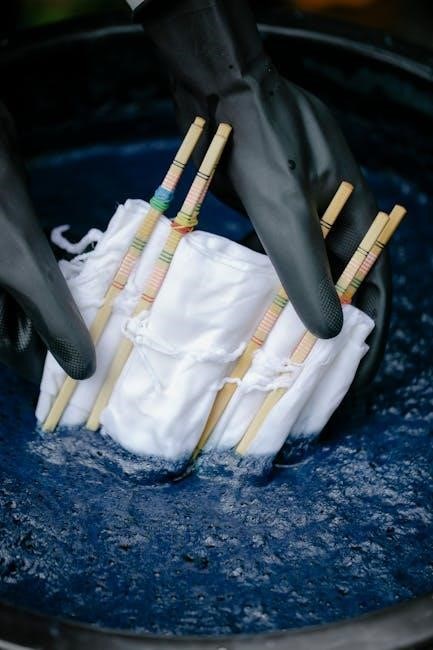
manual water pump for well
Manual water pumps for wells offer a reliable‚ non-electric solution for accessing groundwater‚ ensuring water availability during emergencies or off-grid living‚ with durable‚ low-maintenance designs.
Overview of Manual Water Pumps
A manual water pump is a device designed to extract water from a well using human effort. These pumps operate on a simple mechanism‚ typically involving a piston and cylinder‚ to create suction and lift water to the surface. They are widely used for their reliability‚ sustainability‚ and ability to function without electricity. Manual pumps are ideal for shallow wells‚ rural areas‚ and emergency water supply needs. They offer a cost-effective and eco-friendly solution for accessing groundwater‚ making them a popular choice for off-grid living and temporary water solutions.
Importance of Manual Pumps for Water Supply
Manual water pumps are essential for providing a reliable and sustainable water supply‚ especially in areas with limited access to electricity. They offer a cost-effective solution for extracting water from wells‚ making them ideal for rural and off-grid communities. These pumps are environmentally friendly‚ as they operate without fuel or electricity‚ reducing carbon emissions. Their simplicity ensures longevity and low maintenance‚ making them a practical choice for emergency preparedness and everyday use. Manual pumps also promote water independence‚ allowing users to access groundwater without reliance on external energy sources‚ ensuring a steady supply during power outages or natural disasters.
Key Features of a Reliable Manual Well Pump
A reliable manual well pump should possess durability‚ with materials like stainless steel or durable plastics to withstand external conditions. Its construction needs to be sturdy‚ ensuring a strong handle and frame for effortless operation. Ease of use is crucial‚ featuring a comfortable handle and smooth mechanism for efficient pumping. The pump should deliver a consistent water flow rate‚ ensuring adequate supply with each stroke. High-quality seals and gaskets prevent leaks and maintain smooth operation. Easy maintenance is essential‚ with replaceable parts to extend lifespan. Cost-effectiveness balances price and performance‚ offering good value. Additionally‚ features like built-in filters or anti-corrosion coatings enhance reliability and longevity.

Types of Manual Water Pumps for Wells
Manual water pumps for wells include shallow well‚ deep well‚ and diaphragm pumps‚ each designed for specific water depth and flow requirements‚ ensuring efficient operation.
Shallow Well Hand Pumps
Shallow well hand pumps are designed for wells with water levels up to 25 feet deep. These pumps are ideal for small-scale water needs‚ such as irrigation or household use. They are simple‚ cost-effective‚ and easy to install‚ making them popular in rural or off-grid settings. Constructed from durable materials like stainless steel or PVC‚ they ensure long-term reliability. Shallow well pumps operate by creating suction to draw water to the surface‚ offering a consistent flow rate of up to 10 gallons per minute. Their compact design and manual operation make them a practical choice for areas with limited resources or power availability.
Deep Well Hand Pumps
Deep well hand pumps are designed for wells with water levels ranging from 25 to 300 feet deep. These pumps are more complex than shallow well pumps‚ often featuring a piston and cylinder mechanism to lift water from greater depths. They are ideal for larger households or small communities with higher water demands. Constructed from heavy-duty materials like stainless steel or cast iron‚ deep well pumps are durable and long-lasting. While they require more effort to operate‚ they provide a reliable water supply in areas with deeper water sources. Regular maintenance is essential to ensure optimal performance and longevity.
Comparison of Shallow and Deep Well Pumps
Shallow well pumps are suitable for wells with water levels up to 25 feet‚ while deep well pumps handle depths from 25 to 300 feet. Shallow pumps are simpler‚ lighter‚ and easier to install‚ making them ideal for small-scale use. Deep pumps are more robust‚ with heavier construction and higher lifting capacity‚ suited for larger households or commercial needs. Shallow pumps require less maintenance but are less versatile‚ whereas deep pumps offer reliability for long-term use despite requiring more effort and upkeep. The choice depends on well depth and water demand‚ ensuring efficient operation for specific applications.

Installation and Setup of Manual Well Pumps
Installing a manual well pump involves assessing the well depth and water level‚ then attaching the pump vertically to the casing. Connect the suction pipe‚ ensuring it’s submerged below the water level‚ and secure the discharge pipe for water flow. Prime the pump with water‚ test by pumping the handle to create suction‚ and ensure all connections are tight. Place the pump in a protected‚ convenient location‚ anchor it if necessary‚ and consider adding a check valve to prevent backflow. Regular maintenance‚ like monthly inspections and lubrication‚ is essential for longevity and efficiency.
Step-by-Step Installation Guide
Begin by preparing the well and ensuring the casing is clear of debris. Assemble the pump according to the manufacturer’s instructions‚ typically involving attaching the handle‚ rod‚ and cylinder. Secure the pump to the well casing using provided hardware to prevent movement. Submerge the suction pipe below the water level‚ ensuring proper alignment. Connect the discharge pipe to direct water flow. Prime the pump by filling it with water to eliminate air pockets. Test the pump by operating the handle to check for smooth water flow. Anchor the pump base if necessary‚ and install a check valve to prevent backflow. Ensure all connections are tightened for optimal performance.
Tools and Materials Required
Installing a manual water pump requires specific tools and materials to ensure a successful setup. Essential tools include a wrench‚ pliers‚ screwdrivers‚ a drill‚ and a saw for cutting pipes. Materials needed are the pump kit‚ suction and discharge pipes‚ fittings‚ gaskets‚ and seals. Primer or lubricant may be necessary for initial setup. Safety gear like gloves and goggles is recommended. Ensure all components are compatible with your well casing and water conditions. Having these tools and materials ready helps streamline the installation process and prevents delays;
Measuring Static Water Level
Measuring the static water level is crucial for proper pump installation. This level indicates the water depth in the well when not in use. To measure‚ insert a weighted string or wooden dowel into the well casing until it touches the water. Mark the string at ground level and measure its length. Alternatively‚ use a water level meter for accuracy. This measurement helps determine the pump’s placement and ensures it operates efficiently. Accurate measurement prevents over-pumping and maintains water supply sustainability. Record the measurement for future reference and adjustments.
Ensuring Proper Well Casing Compatibility
Proper well casing compatibility is essential for efficient pump operation. The casing must align with the pump’s dimensions and material to prevent leaks and ensure durability. Measure the casing’s inner diameter to select a pump that fits securely. Materials like PVC‚ steel‚ or fiberglass must match the pump’s design for compatibility. Avoid using pumps with components that could damage the casing. Improper fit or material mismatch can lead to reduced performance or system failure. Always consult the manufacturer’s specifications to ensure compatibility and safe operation. Proper alignment ensures long-term reliability and optimal water supply from the well.

Maintenance and Care of Manual Well Pumps
Regular maintenance ensures longevity and efficiency. Inspect moving parts‚ lubricate hinges‚ and check for wear; Protect from harsh weather and corrosion. Clean and store properly when not in use.
Regular Maintenance Tasks
Regular maintenance is crucial for optimal performance. Lubricate moving parts‚ inspect for wear‚ and replace damaged components. Clean the pump and intake screen to ensure proper water flow. Check the alignment and balance of the handle and pump rod. Monitor the pump’s suction and discharge valves for blockages. Keep the surrounding area clear of debris to prevent contamination; Inspect the well casing for damage or corrosion. Test the pump periodically to ensure consistent water flow. Address minor issues promptly to avoid major repairs. Regular upkeep extends the pump’s lifespan and ensures reliable water supply.
Replacing Worn-Out Parts

Replacing worn-out parts is essential for maintaining pump efficiency. Common parts needing replacement include O-rings‚ valves‚ and gaskets. Regularly inspect these components for signs of wear or corrosion. When replacing‚ use parts recommended by the manufacturer to ensure compatibility and performance. Disconnect the pump from the well and drain water before starting. Follow the manufacturer’s instructions for disassembly and reassembly. Properly align and secure new parts to prevent leaks or misalignment. Test the pump afterward to ensure proper function. Timely replacements prevent major breakdowns and maintain reliable water supply. Always keep spare parts on hand for quick repairs.
Freeze Protection Measures
Protecting manual well pumps from freezing is crucial for long-term functionality. Insulate exposed pipes and the pump with foam insulation or heat tape. Drain water from the pump and pipes during cold snaps to prevent ice formation. Install the pump in a sheltered location‚ such as a well house‚ to shield it from harsh winds. Consider using antifreeze solutions in extreme conditions‚ though this is less common for manual pumps. Regularly check for gaps in insulation and seal them to prevent cold air exposure. These measures ensure the pump operates reliably during winter months without damage from freezing temperatures.
Cleaning and Sanitizing the Pump
Regular cleaning and sanitizing of a manual well pump are essential to ensure safe water supply and optimal performance. Start by disassembling removable parts and soaking them in a mixture of water and white vinegar to dissolve mineral deposits. Use a soft brush to scrub away stubborn sediment or algae. Rinse thoroughly with clean water and allow parts to dry. Sanitize the pump by flushing it with a mild bleach solution‚ ensuring all components are disinfected. Reassemble the pump and test it to confirm proper function. Regular cleaning prevents bacterial growth and maintains water quality‚ ensuring reliable operation over time.

Troubleshooting Common Issues
Identify common issues like low flow or leakage by inspecting pump components. Check for misalignments‚ worn parts‚ or blockages. Ensure proper installation and maintenance for optimal performance.
Low Water Flow or No Water
Low water flow or no water from a manual well pump can result from several issues. Check if the pump is properly primed and ensure the water level in the well is adequate. Inspect for clogged pipes‚ worn-out valves‚ or blockages in the inlet screen. Verify that the pump is correctly installed and aligned with the well casing. If the static water level is too low‚ the pump may not reach the water. Clean or replace the check valve if it’s faulty‚ and ensure all connections are tight. Testing the pump after adjustments can confirm if the issue is resolved.
Leakage in the Pump System
Leakage in a manual water pump system often occurs due to worn-out O-rings‚ gaskets‚ or loose connections. Inspect the pump cylinder‚ spool‚ and valve seats for signs of wear. Tighten any loose bolts or fittings‚ and replace damaged seals or gaskets. Corrosion or mineral buildup can also cause leaks‚ so clean or replace affected parts. Ensure the pump is properly aligned during installation to avoid unnecessary stress on components. Regular lubrication of moving parts can prevent excessive wear. Addressing leaks promptly prevents water loss and maintains pump efficiency.
Difficulty in Pumping
Difficulty in pumping with a manual well pump can arise from air leaks in the suction pipe or pump cylinder‚ reducing efficiency. Check for gaps or cracks and seal them promptly. Misalignment of the handle or excessive friction in moving parts can also make pumping harder. Lubricate hinges and pivot points regularly. Additionally‚ if the static water level is too deep for the pump’s design‚ it may struggle to draw water effectively. Ensure the pump model matches the well’s depth and maintain proper alignment to ease operation and extend the pump’s lifespan.
Addressing Corrosion and Rust

Corrosion and rust on manual well pumps can lead to structural weakening and contamination of the water supply. Regular inspection is crucial to identify early signs of rust. Apply rust-inhibiting coatings to metal components and consider cathodic protection for added defense. Stainless steel or PVC parts are ideal for durability. Clean the pump periodically to remove debris that may accelerate corrosion. If rust is present‚ sand or chemically treat the affected areas before applying a protective sealant. Replace severely corroded parts immediately to prevent further damage and ensure safe‚ reliable water access.

Upgrading and Customizing Manual Pumps
Upgrading manual well pumps can enhance efficiency and convenience. Options include adding motorized or solar-powered components‚ integrating with plumbing systems‚ or modifying materials for improved durability and performance.
Adding a Motorized or Solar-Powered Upgrade
Upgrading a manual well pump with a motorized or solar-powered system enhances functionality and efficiency. Motorized upgrades involve installing an electric motor‚ automating the pumping process and eliminating manual effort. Solar-powered upgrades harness sunlight for operation‚ offering a sustainable and eco-friendly solution. Both options require careful consideration of power supply‚ compatibility with the existing pump system‚ and installation requirements. Motorized systems provide consistent performance but rely on electricity‚ while solar systems offer renewable energy with potential cost savings over time. Assessing specific needs and environmental conditions helps determine the best upgrade path.
Integrating with Existing Plumbing Systems
Integrating a manual well pump with existing plumbing systems enhances water accessibility and convenience. Start by ensuring compatibility between the pump’s output and the plumbing infrastructure. Use appropriate adapters or converters to connect the pump to pipes and fixtures. Consider the water pressure and flow rate to maintain system balance. Installing check valves and pressure gauges helps regulate water flow. Professional installation is recommended to ensure seamless integration and avoid leaks or damage. Proper integration allows for efficient water distribution‚ making manual pumps a reliable component of a comprehensive water supply system.
Enhancing Pump Performance
Enhancing the performance of a manual well pump involves regular maintenance and strategic upgrades. Cleaning the pump cylinder and piston regularly ensures smooth operation. Lubricating moving parts reduces friction and wear. Replacing worn-out seals or O-rings improves water tightness and efficiency. Adjusting the pump handle for optimal leverage can make pumping easier. Using high-quality‚ durable materials for components like rods and cylinders enhances longevity. Proper alignment and balancing of parts during installation also boost performance. These steps ensure the pump operates efficiently‚ delivering consistent water flow and reliability over time.

Applications of Manual Well Pumps
Manual well pumps are ideal for emergency backup water supplies‚ off-grid living‚ and temporary water solutions. They provide reliable access to groundwater in remote or rural areas.
Emergency Backup Water Supply
Manual well pumps serve as an essential emergency backup water supply during power outages or natural disasters. They ensure access to clean water for drinking‚ cooking‚ and hygiene when electricity fails. Unlike electric pumps‚ manual pumps operate independently‚ making them a reliable solution in crisis situations. Their simplicity and durability provide peace of mind‚ knowing water is always available. This makes them a critical component in emergency preparedness kits for homes‚ especially in areas prone to hurricanes‚ earthquakes‚ or floods. Investing in a manual pump can be a lifesaving decision in times of need.
Off-Grid and Rural Living
Manual water pumps are ideal for off-grid and rural living‚ where electricity is scarce or unreliable. They provide a self-sufficient way to access water for drinking‚ irrigation‚ and household needs. In remote areas‚ these pumps are essential for homesteads‚ farms‚ and cabins‚ ensuring a steady water supply without dependence on power grids. Their reliability and low environmental impact make them a popular choice for those seeking sustainable living solutions. Manual pumps also reduce operating costs and provide peace of mind for families living in isolated regions.
Temporary Water Solutions
Manual water pumps are an excellent solution for temporary water needs in various situations. During emergencies such as power outages‚ natural disasters‚ or when a primary water source is unavailable‚ they provide a reliable means to access water without needing electricity. They are also ideal for outdoor activities like camping‚ at temporary construction sites‚ or in seasonal residences where installing a permanent water system isn’t practical. The portability‚ ease of setup‚ and minimal maintenance requirements make manual pumps a highly convenient option for short-term water supply needs. Plus‚ they offer a cost-effective alternative until a more permanent solution is established‚ ensuring continuous access to water when it’s needed most. Their versatility and ease of use make them a valuable asset in any temporary setting.
Manual water pumps for wells are reliable‚ simple‚ and durable solutions for water supply needs‚ offering versatility for emergency‚ off-grid‚ and temporary use‚ while being cost-effective and environmentally friendly.

Final Thoughts on Manual Well Pumps
Manual well pumps are a reliable‚ eco-friendly‚ and cost-effective solution for water supply‚ ideal for off-grid living and emergencies. Their simplicity and durability make them a sustainable choice‚ requiring minimal maintenance. While they may lack the convenience of electric pumps‚ their ability to function without electricity is a significant advantage. For those seeking a practical and long-lasting water solution‚ manual pumps are an excellent option. Proper installation and care ensure years of service‚ making them a valuable investment for any well owner.
Recommendations for Potential Buyers
When selecting a manual well pump‚ consider your water needs‚ well depth‚ and intended use. For shallow wells‚ a simple hand pump suffices‚ while deeper wells may require more robust models. Assess the materials for durability‚ such as stainless steel or food-grade plastics. Budget-friendly options are available‚ but prioritize quality for long-term reliability. Consider off-grid compatibility and ease of maintenance. Ensure the pump aligns with local regulations and well casing specifications. For emergency preparedness‚ opt for a versatile‚ corrosion-resistant model. Lastly‚ check supplier reviews and warranties to make an informed decision tailored to your specific requirements.